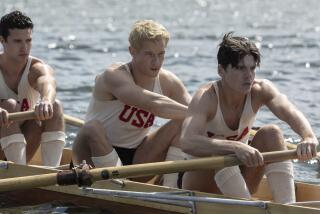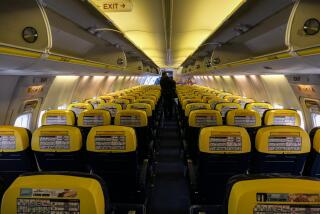Rowers pull past limits in voyage across the Atlantic
Vicki Stevens can’t stop staring at the dot. She hops online first thing in the morning, and four more times a day to check on the little green circle, creeping with agonizing slowness across the digital map toward the Americas.
“Everybody’s always asking -- ‘How far has the dot gone?’ ” Stevens said.
The dot shows the plodding progress of a plywood vessel, akin to an oversized bathtub, that Stevens’ friend Angela Madsen and a partner are rowing across the Atlantic.
Madsen of Long Beach is paraplegic; part of her cohort’s left leg is amputated. Between the two of them, there is one working leg.
After two months at sea, battered by 13-foot waves and in nearly constant pain, Madsen is tantalizingly close to her destination, the Caribbean island of Antigua.
The trip will take longer than Christopher Columbus’ second voyage to the Caribbean. But Madsen says she never questioned whether she should compete in the Atlantic Rowing Race: “I don’t set near as many limits for myself as society sets for me.”
When the boat glides into English Harbour sometime this week, a friend will meet Madsen bearing the wheelchair she abandoned Dec. 2 when she left Spain’s Canary Islands. And Madsen already knows what she wants when she reaches the finish line: a Coke.
Friends tracking her progress have watched as the green dot moved southwest from the Canaries off Africa before making a turn near the Tropic of Cancer. She and fellow rower Franck Festor have traveled more than 2,500 miles so far.
Madsen and Festor, a civilian army employee from France, have put at least $150,000 of their own money into the race, which began with 22 boats. They connected as part of a group of disabled rowers and are the only disabled people in the race.
Festor packed hundreds of pudding cups and canned vegetables. Madsen, a health nut, stowed salmon jerky, fruit leathers and stores of dehydrated potato or risotto meals they prepare with their water desalinator and camp stove. Bathroom accommodations consist of hand wipes and a bucket that gets emptied into the waves.
Life aboard the “Row of Life,” as their craft is named, is “like riding a bull trying to brush your teeth,” Madsen said by satellite phone from her 24-by-6-foot craft.
The sleeping quarters can get so turbulent, Madsen labels them “the mosh pit.” The two spend virtually the whole day rowing together, with 15-minute breaks during the day and alternating solo shifts at night, covering 45 to 60 miles a day.
Though the boats appear bunched up on the website tracking their progress, Madsen and Franck haven’t encountered any of the other 19 still racing. Two boats dropped out due to illness and a traumatic rescue of a man overboard.
Spectators can track all the rowers’ progress at www.atlanticrowingrace2007.co.uk
For Madsen and Festor, mishaps have been relatively few, though there was the time a flying fish smacked her in the face.
The first three days of their voyage, the pair were sidelined by seasickness and exhaustion from around-the-clock boat preparations. And Festor has been putting Madsen’s shoes on for her, since bending has become difficult, she said.
The two don’t talk much, since Madsen can’t speak French -- other than choice expletives -- and Festor doesn’t know English; but with the United Nations flag flapping from their boat, they’re working together just fine, she said.
She left for the starting line at La Gomera despite her family’s disapproval. Her granddaughters feared the tiny craft of marine plywood wouldn’t be much protection against squalls and sharks.
“Nobody believed in us,” said Madsen, 47.
Debra Moeller, a friend who helped see Madsen off at the starting line, caught sight of one of the rowboats, to her alarm: “Those boats are just so tiny in that vast ocean.”
“I think it’s nuts! You couldn’t pay me to do that” said Stevens, a volunteer at the program for disabled rowers that Madsen founded in Long Beach.
“You can’t ever tell Angela no,” Stevens said. “The minute you tell her she can’t do something . . . she’s going to do it.”
Madsen, once a mechanical engineer, never thought she’d be bobbing in the middle of the Atlantic, or competing in the paralympic games as she’s scheduled to do this summer in Beijing. But a botched back surgery in 1993 to fix an injury from her days on the Marine Corps’ women’s basketball team left her unable to walk.
Madsen was angry and sad at first. She gave up her dreams to surf competitively. But she swallowed her self-pity.
As she once said of rowing, “Sometimes the wind takes you a direction you don’t want to go.”
So she learned to row and dedicated herself to helping kids with disabilities do the same. She relearned to surf, on her knees.
That process, reinventing herself as someone with a disability -- a word she hates, preferring “differently abled” -- was the hard part. Rowing 2,900 miles across the ocean is “not harder than laying on a hospital bed for three months and losing everything,” she said.
The “Row of Life” is in the middle of the pack of competitors and hasn’t had any special accommodations from race officials.
And that’s fine with Madsen. She’s already thinking of other possible adventures. Perhaps in Pamplona, rolling with the bulls.
susannah.rosenblatt@latimes.com
--
(BEGIN TEXT OF INFOBOX)
Atlantic Rowing Race facts and figures
* The 2,931-mile race takes place every two years.
* Two-person boats typically finish in about 50 days.
* Each boat is outfitted with a global positioning tracking device; two rescue yachts patrol the route.
* There are solo, two-person and four-person vessels.
* Race entry fees are $30,000; boats cost about $80,000.
* The prize: a trophy.
Source: Woodvale Challenge,
race organizer and maker of
ocean rowing vessels
More to Read
Sign up for The Wild
We’ll help you find the best places to hike, bike and run, as well as the perfect silent spots for meditation and yoga.
You may occasionally receive promotional content from the Los Angeles Times.






